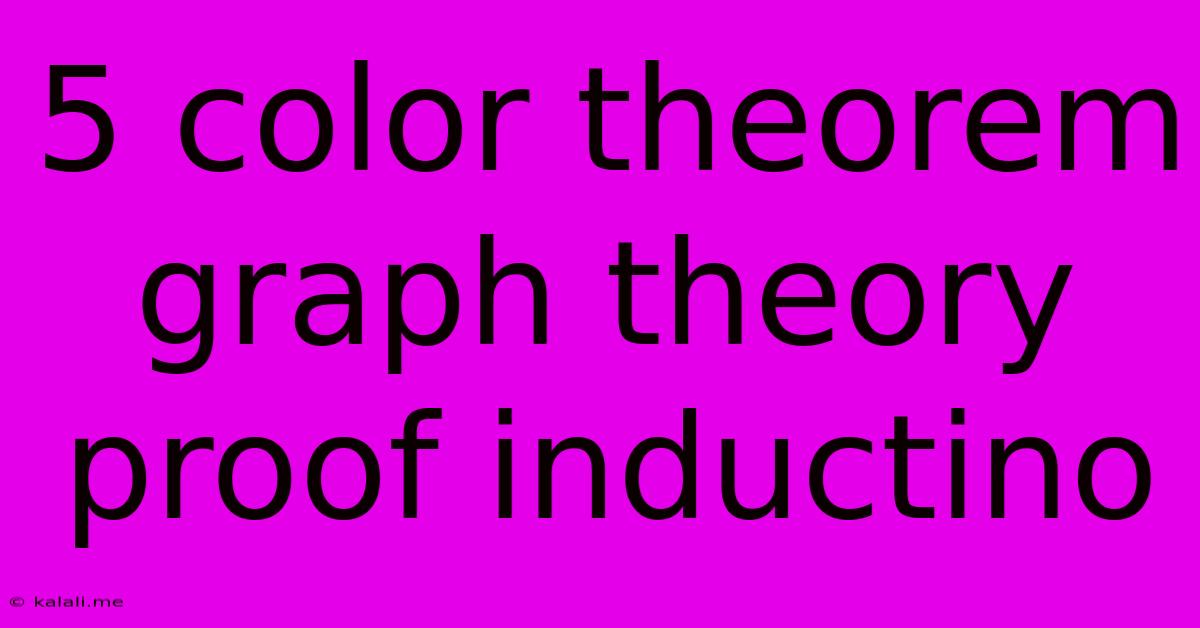5 Color Theorem Graph Theory Proof Inductino
Kalali
May 23, 2025 · 3 min read

Table of Contents
5 Color Theorem: A Proof by Induction (Simplified Explanation)
The Five Color Theorem, a cornerstone of graph theory, states that any planar graph (a graph that can be drawn on a plane without any edges crossing) can be colored with at most five colors in such a way that no two adjacent vertices share the same color. While the Four Color Theorem (that four colors suffice) exists and is famously complex to prove, the Five Color Theorem offers a more accessible demonstration, leveraging the power of mathematical induction. This article provides a simplified explanation of a proof by induction for the Five Color Theorem, focusing on the core concepts and avoiding overly technical details.
Understanding the Problem and Approach
Before diving into the induction, let's clarify the key elements: We're dealing with planar graphs, meaning graphs that can be drawn on a plane without edge crossings. The goal is to prove that every such graph can be colored using a maximum of five colors. Our proof strategy employs induction on the number of vertices in the graph.
Base Case: Small Graphs
The base case of our induction is straightforward. Graphs with one, two, three, four, or five vertices are trivially five-colorable. We can easily assign distinct colors to each vertex without any conflicts.
Inductive Hypothesis:
This is the heart of the inductive argument. We assume that the Five Color Theorem holds true for all planar graphs with k vertices, where k is some arbitrary positive integer. This means that any planar graph with k vertices can be colored with at most five colors.
Inductive Step: Adding a Vertex
Now, consider a planar graph G with k+1 vertices. We need to show that G is also five-colorable. Here’s where the cleverness comes in:
-
Remove a Vertex: Select any vertex v from G and temporarily remove it along with its incident edges. This leaves us with a smaller graph G’ containing only k vertices.
-
Color the Smaller Graph: By our inductive hypothesis, G’ is five-colorable. Let's assume we've colored it using at most five colors.
-
Reintroducing the Vertex: Now, the crucial step: reintroduce vertex v and its edges back into the graph. We need to find a color for v that doesn't conflict with its neighbors. Since G is planar, vertex v can have at most five neighbors (this is a consequence of Euler's formula for planar graphs, a result we won't prove here).
-
Finding a Suitable Color: If v has four or fewer neighbors, there's always at least one color available from our five-color palette that is not used by its neighbors. We can assign this color to v, completing the five-coloring of G.
-
Handling Five Neighbors: The more challenging scenario is when v has five neighbors, each colored differently. However, even in this case, it can be shown (though this requires a detailed combinatorial argument often involving case analysis and sub-graphs) that there's always a way to rearrange colors among the neighbors of v to create a spare color for v itself. This crucial step relies on the properties of planar graphs and is often where the detailed proofs become extensive.
Conclusion: The Five Color Theorem Holds
By successfully completing the inductive step, we've demonstrated that if the Five Color Theorem holds for graphs with k vertices, it also holds for graphs with k+1 vertices. Combined with the base case, this completes the proof by mathematical induction. Therefore, the Five Color Theorem is true: every planar graph can be colored with at most five colors. Note that this proof doesn't explicitly construct the coloring algorithm; it only proves the existence of such a coloring. The actual process of finding the optimal coloring is a separate computational problem.
Latest Posts
Latest Posts
-
How Many Grams Is Half An Oz
Jul 06, 2025
-
How Much Is 10 Quarters In Dollars
Jul 06, 2025
-
How Do You Beat Stage 9 On Bloxorz
Jul 06, 2025
-
What Is 1 2 Equivalent To In Fractions
Jul 06, 2025
-
How Do You Say Pork In Spanish
Jul 06, 2025
Related Post
Thank you for visiting our website which covers about 5 Color Theorem Graph Theory Proof Inductino . We hope the information provided has been useful to you. Feel free to contact us if you have any questions or need further assistance. See you next time and don't miss to bookmark.